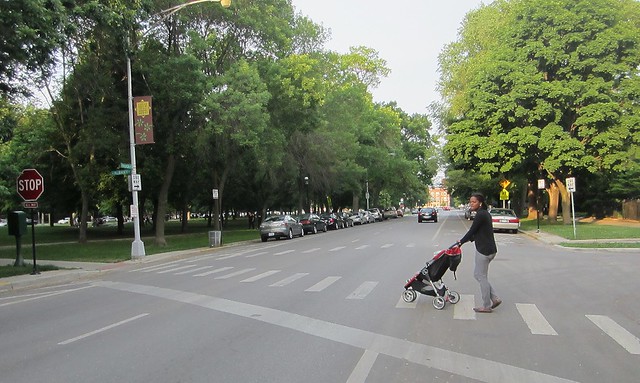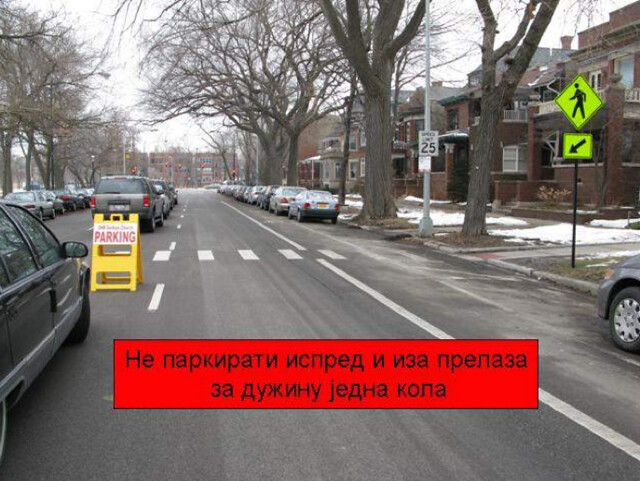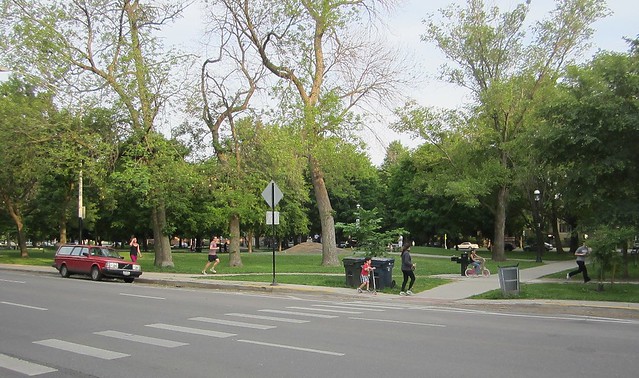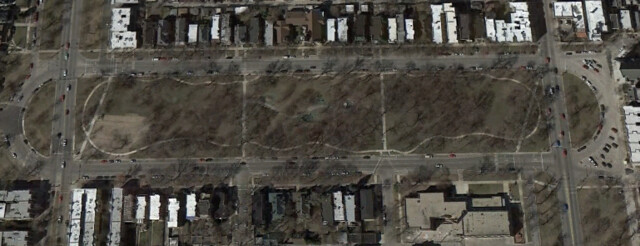Last month, a DNAinfo.com article drew attention to a new campaign to improve pedestrian safety at Palmer Square by installing raised crosswalks, also known as speed tables. Unfortunately, factual errors in the piece left the impression that raised crosswalks would be an expensive solution that doesn't have the Chicago Department of Transportation's approval. It turns out that speed tables would be quite affordable, and CDOT first proposed adding them years ago. Other changes to the roadway could further discourage speeding and enhance the park – if only the park's neighbors would allow them.
Ever since Palmer Square got new playground equipment and a soft-surface track in 2009, the green space has become increasingly popular with families and other Logan Square residents seeking recreation and relaxation. However, the current street layout encourages fast driving, which endangers people crossing to the park, as well as cyclists on Palmer Boulevard.
The eastbound portion of the boulevard runs south of the oval-shaped park, with two travel lanes plus a bike lane. Stop signs at the three-way intersections of Palmer and Albany Avenue, as well as Palmer and Whipple Street, help to calm motorized traffic.

However, on the north side of the green space, there are three westbound travel lanes, plus a bike lane. Albany and Whipple don't continue north of the park, so there are no intersections or stop signs on the quarter-mile stretch between Sacramento and Kedzie boulevards, which makes it easy for drivers to pick up speed.
While there are marked, midblock crosswalks on the north side of Palmer Square where Albany and Whipple would be, the three travel lanes create long crossing distances and the so-called “multiple threat” scenario. Even if one driver obeys the law by stopping for pedestrians in the crosswalk, there’s no guarantee that the motorist in the next lane will do so.
Two churches near the square encourage their parishioners to park in the central lane on the north side of the green space during services and special events. That’s technically illegal, but has been condoned by the local aldermen in the past. This practice further endangers pedestrians, because it makes it more difficult for westbound drivers to see people crossing the street.
As DNAinfo reported, residents have launched an online petition calling for installing raised crosswalks on the northern portion of the boulevard at Albany and Whipple. “A park designed for and frequented by very small children, residential homes and a church borders this portion of the street,” the petition reads. “A school also borders the park and school children often utilize the park for physical education and after school programs. The speeding traffic on the street creates a grave safety hazard.”
Using a speed gun, Streetsblog Chicago writer Steven Vance and contributor Justin Haugens confirmed that speeding is commonplace on the north side of the square. During three 15-minute observations between 5:30 and 6:30 p.m. on a recent weeknight, they clocked 168 drivers -- 75 percent of all observed motorists -- exceeding the posted 25 mph speed limit. About a third of all observed drivers were going faster than 30 mph, the default citywide speed limit. Five drivers exceeded 40 mph – studies show that pedestrians struck at that speed almost always die.
Clearly, the speeding problem needs to be addressed, but DNA quoted 32nd Ward Alderman Scott Waguespack as saying that CDOT has not approved “raised intersections” at this location. It turns out the writer was a bit confused. Both CDOT spokesman Pete Scales and 32nd Ward chief of staff Paul Sajovec told me that the transportation department has recommended installing raised crosswalks here.
The DNA article also listed the cost of installing four raised crosswalks at the square at around $550,000. Sajovec told me the speed tables would need to be paid for out of the ward’s $1.3 million in annual discretionary funds. If the DNA figure was accurate, that might seem excessive, as opponents to the idea have argued. However, Scales told me the price tag for the two raised crosswalks at Albany and Whipple would only be $40,000 -- relative chicken feed.
The $550,000 number actually comes from the cost estimate CDOT provided for its proposal for a robust overhaul of the street back in 2008, before the park was renovated. In addition to the raised crosswalks, this reconfiguration would have included a series of curb bumpouts to shorten pedestrian distances, as well as a road diet that would have eliminated the third lane of westbound Palmer. Converting curbside parking on the north side of the street to angled spaces would have created 17 more spots, so church parking would not been significantly impacted.

Back then, Palmer Square was within Alderman Rey Colón’s 35th Ward, and Colón told that he was all for these commonsense safety solutions. “I wanted to get rid of that middle lane,” he said. “There’s more roadway than necessary, and removing a lane would make it more walkable.”
However, Colón said he had a tough enough time convincing many Palmer Square neighbors that the playground equipment and track were a good idea. Many of them were dead-set against having angled parking in front of their homes, even though it would have made it easier to park their cars at all times, not just during church events.
“At the time, people thought it was too much change at once,” Colón said. “Part of the Palmer Square dilemma is its physical layout. People have beautiful, historic houses that look out on the park, and they feel entitled to control their view.” Having already dealt with significant opposition to the park rehab, and with other green spaces in the ward needing attention, he decided to walk away from the lane removal issue.
Sajovec said that Waguespack has no problem with installing raised crosswalks. “They’re certainly not cost-prohibitive,” he said. “Scott’s only concern is that many people who live nearby have been calling, emailing and visiting our offices to oppose them.”
Although the opponents Sajovec has talked to understand that the speed tables would only cost $40,000, some claimed that increased speed enforcement would be a more cost-effective solution. In a letter to Waguespack, Palmer Square resident Corrine Bradley argued that raised crosswalks would delay fire and police vehicles and would be an obstacle to cyclists. First responder concerns are a common, but specious, NIMBY argument against safe-streets proposals, and most cyclists would rather deal with the occasional raised crosswalk than with drivers speeding at over 40 mph.
View Larger Map
Raised crosswalk on a two-lane street with a bike lane by a park in Washington, D.C.
Bradley also complained that speed tables would create constant noise as vehicles pass over them, which seems to be her real concern. Sajovec said it appears some of the neighbors don’t understand the difference between raised crosswalks, which are rare in Chicago, and speed humps, which are common on side streets. Scales said CDOT does not recommend speed humps for this location because of the multiple traffic lanes. “Speed humps are louder than speed tables,” Sajovec said. “You’re more likely to get noise from cars bottoming out and trucks bouncing with speed humps.”
Sajovec said it might make sense to hold a community meeting to educate residents about the raised crosswalk proposal. Alternately, the alderman may do outreach to residents via local community groups, like the Homeowner’s Association of Palmer Square and Logan Square Preservation.
The raised crosswalks would be a relatively inexpensive way to address the speeding problem at a park that’s used by many Logan Square residents. Since CDOT and Waguespack are on board with the idea, the main thing preventing the speed tables from becoming a reality is a relatively small number of NIMBY neighbors. If you live in the ward, and especially if you live on the square, be sure to contact the alderman and let him know you want speed tables now, and more extensive safety improvements in the future.







